西方译论Chapter 4ppt课件
- 格式:ppt
- 大小:699.50 KB
- 文档页数:10
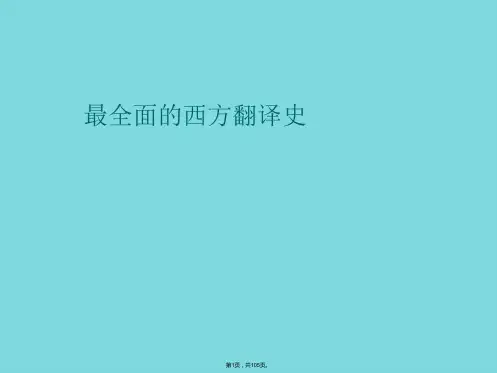
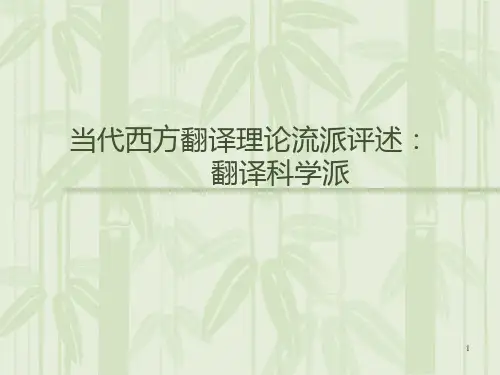

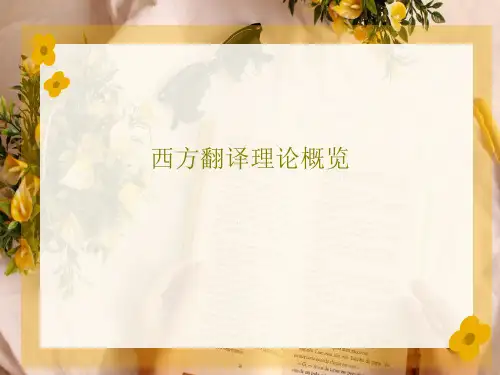

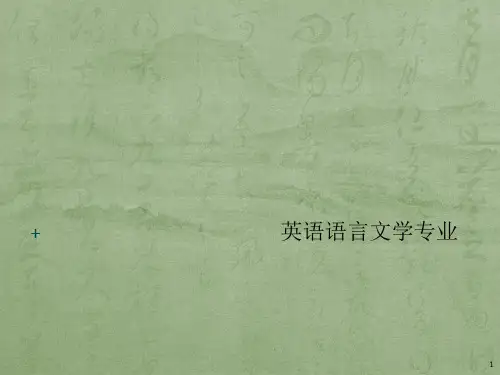
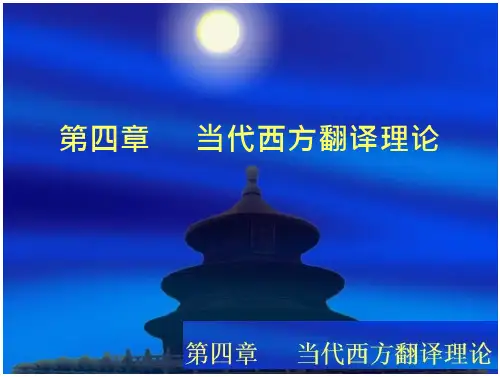
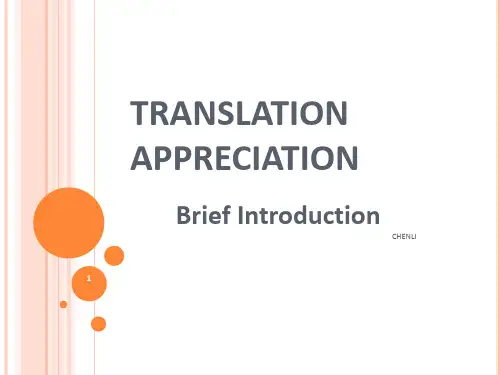
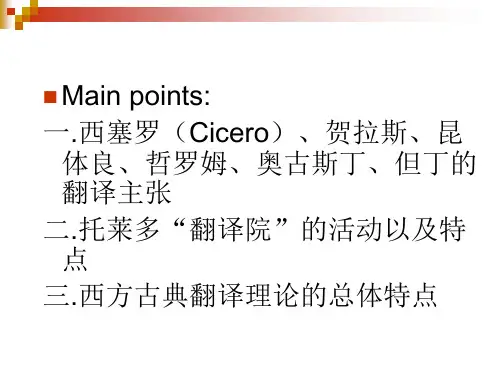
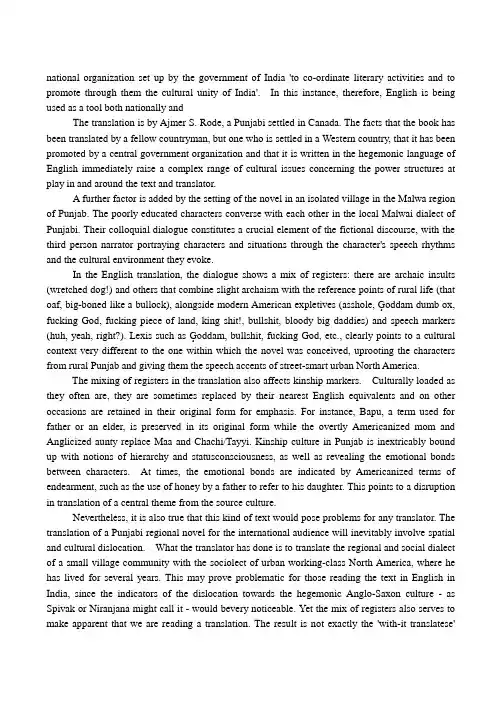
national organization set up by the government of India 'to co-ordinate literary activities and to promote through them the cultural unity of India'. In this instance, therefore, English is being used as a tool both nationally andThe translation is by Ajmer S. Rode, a Punjabi settled in Canada. The facts that the book has been translated by a fellow countryman, but one who is settled in a Western country, that it has been promoted by a central government organization and that it is written in the hegemonic language of English immediately raise a complex range of cultural issues concerning the power structures at play in and around the text and translator.A further factor is added by the setting of the novel in an isolated village in the Malwa region of Punjab. The poorly educated characters converse with each other in the local Malwai dialect of Punjabi. Their colloquial dialogue constitutes a crucial element of the fictional discourse, with the third person narrator portraying characters and situations through the character's speech rhythms and the cultural environment they evoke.In the English translation, the dialogue shows a mix of registers: there are archaic insults (wretched dog!) and others that combine slight archaism with the reference points of rural life (that oaf, big-boned like a bullock), alongside modern American expletives (asshole, Ģoddam dumb ox, fucking God, fucking piece of land, king shit!, bullshit, bloody big daddies) and speech markers (huh, yeah, right?). Lexis such as Ģoddam, bullshit, fucking God, etc., clearly points to a cultural context very different to the one within which the novel was conceived, uprooting the characters from rural Punjab and giving them the speech accents of street-smart urban North America.The mixing of registers in the translation also affects kinship markers. Culturally loaded as they often are, they are sometimes replaced by their nearest English equivalents and on other occasions are retained in their original form for emphasis. For instance, Bapu, a term used for father or an elder, is preserved in its original form while the overtly Americanized mom and Anglicized aunty replace Maa and Chachi/Tayyi. Kinship culture in Punjab is inextricably bound up with notions of hierarchy and statusconsciousness, as well as revealing the emotional bonds between characters. At times, the emotional bonds are indicated by Americanized terms of endearment, such as the use of honey by a father to refer to his daughter. This points to a disruption in translation of a central theme from the source culture.Nevertheless, it is also true that this kind of text would pose problems for any translator. The translation of a Punjabi regional novel for the international audience will inevitably involve spatial and cultural dislocation. What the translator has done is to translate the regional and social dialect of a small village community with the sociolect of urban working-class North America, where he has lived for several years. This may prove problematic for those reading the text in English in India, since the indicators of the dislocation towards the hegemonic Anglo-Saxon culture - as Spivak or Niranjana might call it - would bevery noticeable. Yet the mix of registers also serves to make apparent that we are reading a translation. The result is not exactly the 'with-it translatese'bemoaned by Spivak or the dominant Anglo-American domesticSatinig teanslations casfigated by Venuti (1995; see chapter 9); it is rather a dislocati0nary translation practice that brings into sharp relief the clash of different cultures. The characters are dislodged from their source culture, but they are also made to come alive and challenge the English-language reader. This is the kind of complex interventionist approach the translator has carried out, but he leaves himself open to the criticism that he has chosen to superimpose the sociolect of the hegemonic power.Interestingly enough, the translation of Marhi Da Deeva was followed by the translation of two other Singh novels: Addh Chanini Raat (Night of the Half-Moon, Madras: Macmillan, 1996) and Parsa (National Book Trust, 1999); these translations bring Singh to the attention of an even wider audience and are perhaps indicative of the success of the first translation.Discussion of case studyThis case stud5; which looks at the language of the TT and sees cultural implications in the choices made, has examined a case where a novel from a minority language has been translated into the hegemonic international language (English) under the auspices of a centralized national organization (the Sahitya Akademi). The language of the characters becomes mingled with that of the colonizer, and their identity - embedded in their Punjabi cultural milieu - is blurred. While postcolonial theories help to understand the power relations that operate around the translation process, it is also clear from this brief analysis of The Last Flicker that a whole range of interacting factors are at work. These include the perhaps inevitable dislocation of the source culture, the dislocation of the Punjabi translator in Canada and the location of the patronage within India itself. It would now be interesting to compare the translation strategies employed in the other novels. The aim would be to see how far this translation strategy is due to translation policy or to the way literary translators function in general. The latter is an issue that will be considered in the next chapter.SummaryThis chapter has focused on the varieties of cultural studies in translation studies. Linguistic theories of translation have been sidelined and attention has centred on translation as cultural transfer and the interface of translation with other growing disciplines within cultural studies. Those examined in this chapter have been:·section 8.1: translation as rewriting, developed from systems theories and pioneered by AndréLefevere, studying the power relations and ideologies existing in the patronage and poetics of literary and cultural systems that interface with literary translation;·section 8.2: translation and gender, with the Canadian feminist translation project described by Sherry Simon, making the feminine visible in translation;·section 8.3: translation and postcolonialism, with examples from Spivak, Niranjana and Cronincomparing the 'dislocature' of texts and translators working in former colonies of the European powers or in their languages.Niranjana in particular highlights the power relations in the translation of the colonized peoples and takes translation studies to task for its Western philosophical and ideological bias. Finally, Brazilian cannibalism, as exemplified by de Campos and Vieira, employs the metaphor of devouring the cotonizer to energize the native Brazilian tradition. The next chapter turns to examine the role of translators themselves at the cultural interface.Further readingFor an introduction to cultural studies, read Easthope (1991) or During (1999). For translation as rewriting, read additionally Lefevere (1981, 1985, 1993) and the collection of esays edited by Alvarez and Africa-Vidal (1996) for translation as a political act. Related discussion of issues of patronage follows in chapter 9. for an introduction to gender issues, read Butler (1990) and Buikeana and $melik (1995). For translation and gender, read Godard (1990)andfor the firsrsign that gay issues are beginning to enter the translation forum, read Harvey (1998/2000; see also chapter 11). For an introduction to postcolonialism, read Said (1978). In addition, for translation and postcolonialism read Cheyfitz (1991), Bhabha (1994), and Robinson (1997a), and for Brazilian cannibalism read de Campos (1992) and Vieira (1997).Discussion and research points1 Lefevere sees translation 'as potentially the most influential' (I 992a: 9) form of rewriting. Flowfar do you agree with him? Compare this with examples taken from other forms of rewriting (film adaptations, anthologization, historiography, etc.).2 Lefevere identifies three factors (the professionals, patronage and poetics) which control theliterary system, Examine how each functions in your own culture and which, if any, seems to be most important Are there other factors you would add?3 Should women writers ideally be translated by women only? What about male writers? Look atpublished translations and their prefaces to see how often this could become an issue.4 Look for examples from translations in various times and locations that reveal a gender bias.How is that 'bias' revealed? is there a pattern to these examples? How might the translator have differently?5 How far do you feel Barbara Godard is justified in 'flaunting her manipulation of the text' forfeminist purposes, or Niranjana is justified for her 'interventionist' approach?6 What research work has been carried out on postcolonialism and translation in your owncountry and language(s)? Do the results tie in with those discussed here?7 How far do you agree with Niranjana that translation studies has been overly dominated byWestern theories? If this is true, how can or should the situation be changed?8 'Co-existence implies translating the culture and (political, religious, emotional) language of theother into a language and culture that is strengthened by the presence of the other. The alternative to translation is the muteness of fear' (Cronin 1996: 200). How far does misstatement hold for the linguistic policies of your own country? What examples have you come across of translation involving a power difference between the two languages and cultures?9 Translating the foreign: the (in)visibility of translationKey textsBerman, A. (1984,/92) L'épreuve de I'étranger: Culture et traduction dans I'Allemagne romantique, Paris: Éditions Gallimard; translated (1992) by S. Heyvaert as The Experienceof the Foreign: Culture and Translation in Romantic Germany, Albany: State University ofNew York.Berman, A. (1985b/2000) 'Translation and the trials of the foreign', translated by L. Venuti, in L. Venuti (ed.) (2000), pp. 284-97, (Originally published as 'La traduction comme epreuve de I'éranger', Texte ( 1985): 67-81 ).Felstiner, J. (1980) Translating Neruda: The Way to Macchu Picchu, Stanford, CA: Stanford University Press.Levine, S. (1991) The Subversive Scribe: Translating Lat/n American Fiction, St Paul, MN: Graywolf Press.Venuti, L. (ed.) (1992) Rethinking Translation: Discourse, Subjectivity, Ideology, London and New York: Routledge.Venuti, L. (1995) The Translator's Invisibility:A History of Translation, London and New York:Routledge.Venuti, L. (1998) The Scandals of Translation: Towards an Ethics of Difference, London and New York: Routledge.9.0 IntroductionChapter 8 examined varieties of cultural studies that have focused on translation. In this chapter, we concentrate on other research that deals with cultural difference and with the interface between the source culture and the foreign, linking ideology and dominant discourse to translation strategies.Section 9.1 focuses on- key areas- of--the-influential work of Lawrence Venuti, notably the 'invisibility' of translation and the translator in Anglo-American culture (section 9.1.1) and the 'domesticating' and 'foreignizing' translation strategies which are avail able to the tramslator (section 9,1.2). Section 9.1.3 considers work by Antoine Berman that follows a similar line, Berman's 'negative analytic' attacking the homogenization of the translation of literary prose.The remainder of the chapter considers other related areas and players in the translation process. Thus, in section 9.2 a description is given of what practising literary translators say about their practices, in order to see if their own view of their work tallies with Venuti's and Berman's theories. Section 9.3 deals with crucial aspects of the powerful publishing industry and section 9.4 discusses criticisms of Venuti. Finally, section 9.5 examines the reception of translations, notably the reviewing process, and what this reveals about cultural attitudes to translation in general. Following this, the case study illustrates one method of investigating these ideas by analyzing the reviews of a translated text.9. 1 Venuti: the cultural and political agenda of translationLike the other cultural theorists discussed in chapter 8, Venuti insists that the scope of translation studies needs to be broadened to take account of the value-driven nature of the sociocultural framework. Thus he contests Toury's 'scientific' descriptive model with its aim of producing 'value-free' norms and laws of translation (see chapter 7):Toury's method ... must still turn to cultural theory in order to assess the significance of the data, to analyze the norms. Norms may be in the first instance linguistic or literary,; but they will also include a diverse range of domestic values, beliefs, and social representations which carry ideological force in serving the interests of specific groups. And they are always housed in the social institutions where translations are produced and enlisted in cultural and political agendas.(Venuti 1998: 29)In addition to governments and other politically motivated institutions, which may decide to censor or promote certain works (compare Lefevere's discussion of control factors in section 8.1), thegroups and social institutions to which Venuti refers would include the various players in the publishing industry as a whole. Above all, these would be the publishers and editors who choose the works and commission the translations, pay the translators and often dictate the translation method. They also include the literary agents, marketing and sales teams and reviewers. The reviewers' comments indicate and to some extent determine how translations are read and received in the target culture. Each of these players has a particular position and role within the dominant cultural and political agendas of their time and place. The translators themselves are part of that culture, which they can either accept or rebel against.9.1.1 Venuti and the 'invisibility' of the translatorInvisibility is a term used by Venuti (1995: 1) 'to describe the translator's situation and activity in contemporary Anglo-American culture'. Venuti sees this invisibility as typically being produced:1 by the way translators themselves tend to translate 'fluently' into English, to produce anidiomatic and 'readable' TT, thus creating an 'illusion of transparency';2 by the way the translated texts are typically read in the target culture:A translated text, whether prose or poetry, fiction or non-fiction, is judged acceptable by mostpublishers, reviewers and readers when it reads fluently, when the absence of any linguistic or stylistic peculiarities makes it seem transparent, giving the appearance that it reflects the foreign writer's personality or intention or the essential meaning of the foreign text - the appearance, in other words, that the translation is not in fact a translation, but the 'original'.(Venuti 1995: 1)Venuti (1998:31) sees the most important factor for this as being 'the prevailing conception of authorship'. Translation is seen as derivative and of secondary quality and importance. Thus, the English practice since Dryden has been to conceal the act of translation so that, even now, 'translations are rarely considered a form of literary scholarship' (Venuti 1998: 32).9. 1.2 Domestication and foreignizationVenuti (1995: 19-20) discusses invisibility hand in hand with two types of translating strategy: domestication and foreignization. These strategies concern both the choice 'of text to translate and the translation method. Their roots are traced back by Venuti to Schleiermacher and his 1813 essay 'Űber die verschiedenen Methoden des Űbersetzens' (see chapter 2). Venuti (1995: 21) sees domesticationas dominating Anglo-American translation culture. Just as the postc01onialists are alert to the cultural effects of the differential in power relations between colony and ex-colony, so Venuti (1995: 20) bemoans the phebinebib if domestication.stication since it involves 'anethnocentric reduction of the foreign text to [Anglo-American] target-language cultural values'. This entails teanstating in a transparent, fluent, 'invisible' style-in order to mibunuze the foreugbs of the TT. Venuti allies it with Schkeuermacher's descriprion that 'leaves the reader in peace, as much as possible, and moves the author towards him' (Schleiermacher 1813/1992: 41-2;see chapter 2 of this book). Domestication further covers adheyence to domestic literary canons by carefully selecting the texts that are likely to lend themselves to such a translation strategy (Venuti 1997: 241).Foreignization, on the other hand, 'entails choosing a foreign text and developing a translation method along lines which are excluded by dominant cultural values in the target language' (Venuti 1997: 242). It is the preferred choice of Schleiermacher, whose description is of a translation strategy where 'the translator leaves the writer alone, as much as possible and moves the reader towards the writer' (Schleiermacher 1813/1992: 42). Venuti (1995: 20) considers the foreignizing method to be 'an ethnodeviant pressure on [target-language cultural] values to register the linguistic and cultural difference of the foreign text, sending the reader abroad'. It is 'highly desirable', he says, in an effort 'to restrain the ethnocentric violence of translation'. In other words, the foreignizing method can restrain the 'violently' domesticating cultural values of the English-language world. The foreignizing method of translating, a strategy Venuti also terms 'resistancy' (1995: 305-6), is a non-fluent or estranging translation style designed to make visible the presence of the translator by highlighting the foreign identity of the ST and protecting it from the ideological dominance of the target culture.In his later book The Scandals of Translation (1998), Venuti continues to insist on foreignizing or, as he also calls it, 'minoritizing' translation, to cultivate a varied and 'heterogeneous discourse' (Venuti 1998:11). One of the examples he gives of a minoritizing project is his own translation of works by' the nineteenth-century Italian Tarchetti (pp. 13-20). The choice of works to translate is minoriti:ing since Tarchetti was a minor nineteenth-century Italian writer, a Milanese bohemian who further challenged the literary establishment by using the standard Tuscan dialect to write experimental and Gothic novels and by challenging the moral and political values of the day. As far as the language is concerned, the minoritizing or foreignizing method of Venuti's translation comes through in the deliberate inclusion of foreignizing elements, such as modern American slang, in a bid to make the translator 'visible' and to make the readers realize they are reading a translation of a work from a foreign culture. Venuti gives the extract shown in box9.1 as an example of what he means by this approach.Among the elements of this extract which Venuti considers to be distinctive of foreignization are the close adherence to the ST structure and syntax (e.g. the adjunct positions in the first sentence), the caiques soggiorno as sojourn, indurlo as induce him and the archaic structure nor could I ever. In other passages (see Venuti 1998: 16-17), he juxtaposes both archaisms (e.g. scapegrace) and modern colloquialisms (e.g. con artist, funk), and uses British spellings (e.g.demeanour, offence) to jar the reader with a 'heterogeneous discourse'. "Venuti is happy't0 note (t998; 15) that some of the reviews of the translation were appreciative of his 'visible' translating strategy. However, he also adds (pp. 18-19) that some of the reviews attacked the translation for not being what, in Venuti's terms, would be domestication.Box 9.1Although Venuti advocates foreigni'_ing translation, he is also aware (1995: 29) of some of its contradictions, namely that it is a subjective and relative term that still involves some domestication because it translates an ST for a target culture and depends on dominant target-culture values to become visible when it departs from them. However, Venuti defends foreignizing translations. They 'are equally partial [as are domesticating translations] in their interpretation of the foreign text, but they do tend to flaunt their partiality instead of concealing it' (1995: 34). Importantld; it should also be pointed out at this point that domestication and foreignization are considered bi' Venuti (1999), in the introduction to the Italian translation of TheTranslator's Invisibility, to be 'heuristic concepts ... designed to promote thinking and research' rather than binary opposites: 'They possess a contingent variabilit3, such that they can only be defined in the specific cultural situation in which a translation is made and works its effects.' This, according to Vcnuti, means that the terms may change meaning across time and location. What does not change, however, is that domestication and foreignization deal with 'the question of how much a translation assimilates a foreign text to the translating language and culture, and how much it rather 'signals the differences of that text'. This is a question which had already attracted the attention of the noted French theorist, the late Antoine Berman.9.1.3 Antoine Berman: the 'negative analytic' of translationAntoine Berman's major theoretical work - L'épreuvede l'étranger: Culture, traduction dans l 'Atlemagne romantique (1984), translated into English as The Experience of the Eoreign: Culture and Translation in Romantic Ģermany (1992)- precedes and influences Venuti, who himself has recently produced an English translation of an important article by Berman. This article, 'La traduction comme épreuve de l'étranger' (1985), is entitled 'Translation and the trials of the foreign' in English (in Venuti 2000). The change from experience in the title of the book to trials in the article is perhaps indicative of Venuti' desire to challenge the reader by highlighting the challenge and trials that translation represents to the ST. Berman (2000: 284) describes it as an épreuve ('trial') in two senses:1 a trial for the target culture in experiencing the strangeness of the foreign text and word;2 a trial for the foreign text in being uprooted from its original language context.Berman deplores the general tendency to negate the foreign in translation by the translation strategy of 'naturalization', which would equate with V enuti's later 'domestication'. 'The properly ethical aim of the translatin: act', says Berman (p. 285), is 'receiving the foreign as foreign', which would seem to have influenced Venuti's 'foreignizing' translation strategy, However, Berman considers (p. 286) that there is generally a 'system of textual deformation' in TTs that prevents the foreign coming through. His examination of the forms of deformation is termed 'negative analytic': The negative analytic is primarily concerned with ethnocentric, annexationist translations and hypertextual translations (pastiche, imitation, adaptation, free writing), where the play of deforming forces is freely exercised.(Berman 1985b/2000:286 Berman, who translated Latin American fiction and German philosophy, sees every translator as being inevitably and inherently exposed to these ethnocentric forces, which determine the 'desire to translate' as well as the form of the TT. He feels (p. 286) that it is only by psychoanalytic analysis of the translator's work, and by making the translator aware of these forces that suchtendencies can be neutralized. His main attention is centred on the translation of fiction:The principal problem of translating the novel is to respect its shapeless polylogic and avoid an arbitrary homogenization.(Berman 1985b/2000:287)By this, Berman is referring to the linguistic variety and creativity of the novel and the way translation tends to reduce variation. He identifies twelve 'deforming tendencies' (p. 288):1 Rationalization: This mainly affects syntactic structures including punctuation and sentencestructure and order. Berman also refers to the abstractness of rationalization, the translation of verbs by noun forms and the tendency to generalization.2 Clarification: This includes explicitation, which 'aims to render "clear" what does not wish to beclear in the original' (p. 289).3 Expansion: Like other theorists (for example, Vinay and Darbelnet; see chapter 4), Bermansays that TTs tend to be longer than STs. This is due to 'empty' explicitation that unshapes its rhythm, to 'overtranslation' and to 'flattening'. These additions only serve to reduce the clarity of the work's 'voice'.4 Ennoblement: This refers to the tendency on the part of certain translators to 'improve' on theoriginal by rewriting it in a more elegant style. The result, according to Berman (p. 291), is an annihilation of the oral rhetoric and formless polylogic of the ST. Equally destructive is a TT that is too 'popular' in its use of colloquialisms.5 Qualitative impoverishment: This is the replacement of words and expressions with TTequivalents 'that lack their sonorous richness or, correspondingly, their signifying or "iconic"features' (p. 291). By iconic or iconicity, Berman means terms whose form and sound are in some way associated with their sense. An example he gives is the word butterfly and its corresponding terms in other languages.6 Quantitative impoverishment: This is loss of lexical variation in translation. Berman gives theexample of a Spanish ST that uses three different synonyms for face (semblante, rostro and tara); rendering them all as face would involve loss.7 The destruction of rhythms: Although more common in poetry, rhythm is still important to thenovel and can be 'destroyed' by deformation of word order and punctuation.8 The destruction of underlying networks of signification: The translator needs to be aware of thenetwork of words that is formed throughout the text. Individually, these words may not be significant, but they add an underlying uniformity and sense to the text. Examples are augmentative suffixes in a Latin American text (jaul6n, port6n, etc.).9 The destruction of linguistic patternings: While the ST may be systematic in its sentenceconstructions and patternings, translation tends to be 'asystematic' (p. 293). The translator likely adopts a range of techniques, such as rationalization, clarification and expansion which, although making the TT linguistically more homogenous, also render it more 'incoherent'because the systematicity of the original is destroyed.10 The destruction of vernacular networks or their exoticization: This relates especially to localspeech and language patterns which play an important role in establishing the setting of a novel. There is severe loss if these are erased, yet the traditional solution of exoticizing some of these terms by, for example, the use of italics, isolates them from the co-text. Alternatively, seeking a TL vernacular or slang is a ridiculous exoticization of the foreign (compare the case study from Punjabi in chapter 8).11 The destruction of expressions and idioms: Berman considers the replacing of an idiom orproverb by its TL 'equivalent' to be an 'ethnocentrism': 'to play with "equivalence" is to attack the discourse of the foreign work', he says (p. 295). Thus, an English expression from Conrad containing the name of the well-known insane asylum Bedlam, should not be translated by 'Charenton', a French insane asylum, since this would result in a TT that produces a network of French cultural references.12 The effacement of the superimposition of languages: By this, Berman means the waytranslation tends to erase traces of different forms of language that co-exist in the ST. These may be the mix of peninsular and Latin American Spanishes in the work of Valle-Inclán, the proliferation of language influences in Joyce's Finnegan's Wake, different sociolects and idiolects, and so on. Berman (p. 296) considers this to be the 'central problem' in the translation of novels.Counterbalancing the 'universals' of this negative analytic is Berman's 'positive analytic' (pp. 286, 296-7), his proposal for the type of translation required to render the foreign in the TT. This he calls 'literal translation':Here 'literal' means: attached to the letter (of works). Labor on the letter in translation, on the one hand, restores the particular signifying process of works (which is more than their meaning) and, on the other hand, transforms the translating language.(Berman 1985b/2000:297)Berman's term is markedly different and more specific compared to the conventional use of literal translation discussed in chapter 2; his use of literal and letter and his reference to the 'signifying process' point to a Saussurean perspective and to a positive transformation of the TL. The term literal is also discussed by Venuti (1995: 146-7), who construes the letter as 'the range of signifying possibilities in the TL'.Berman's work is important in linking philosophical ideas to translation strategies with many examples drawn from existing translations. His discussion of the ethics of translation as witnessed in linguistic 'deformation' of TTs is of especial relevance and a notable counterpoint to earlier writing on literary translation. Yet, despite Berman's concern for the foreign in translation, it is Venuti's work that has attracted more attention and aggressive reaction (see section 9.4). The。
